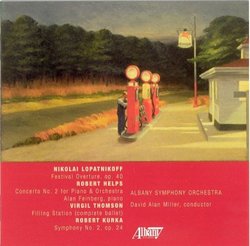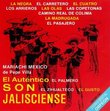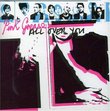| All Artists: Robert Helps, Robert Kurka, Nikolai Lopatnikoff, Virgil Thomson, David Alan Miller, Albany Symphony Orchestra, Alan Feinberg Title: Robert Kurka Symphony No.2 .Albany Symphony Members Wishing: 0 Total Copies: 0 Label: Albany Records Original Release Date: 1/1/2003 Re-Release Date: 7/29/2003 Album Type: Hybrid SACD - DSD Genre: Classical Styles: Ballets & Dances, Ballets, Forms & Genres, Concertos, Historical Periods, Modern, 20th, & 21st Century, Symphonies Number of Discs: 1 SwapaCD Credits: 1 UPC: 034061059127 |
Search - Robert Helps, Robert Kurka, Nikolai Lopatnikoff :: Robert Kurka Symphony No.2 .Albany Symphony
 | Robert Helps, Robert Kurka, Nikolai Lopatnikoff Robert Kurka Symphony No.2 .Albany Symphony Genre: Classical |
Larger Image |
CD DetailsSimilar CDs
|
CD ReviewsAn Energy-Rich Power Bar with a Soft Creme Center J Scott Morrison | Middlebury VT, USA | 08/14/2003 (5 out of 5 stars) "Ah, an all-American music program from the ever-resourceful David Alan Miller and his Albany Symphony Orchestra. And a neatly balanced program it is, too, with two energetic and brash pieces (Lopatnikoff and Helps) and a neoclassic discovery (Kurka) bracketing a piece of Thomson faux-naïve Americana. Perfect.Nikolai Lopatnikoff (1903-1976), although an Estonian by birth, was an American composer mostly based in Pittsburgh. His 'Festival Overture,' commissioned by the Pittsburgh Plate Glass Company, is a 10-minute opener in ABA form, with an engagingly percussive and joyous first section, polytonal and rhythmically complex, followed by a lyrical middle section. The first section returns, altered a bit, to close with a bang. This is the kind of piece that gets your toe tapping, even if your toe doesn't always quite know where the downbeat is!Composer Robert Helps (1928-2001) was primarily known as an adventuresome pianist who specialized in contemporary American music much like the pianist in this performance of his one-movement Second Piano Concerto, Alan Feinberg. The latter, who seems to be everywhere these days [and the release of whose recording of the Ives 'Emerson' Concerto we are eagerly awaiting], plays the excruciatingly difficult piano part of the concerto with such aplomb that you'd think it was Clementi or Carl Maria von Weber. Goodness! It's hard to imagine the concerto's dedicatee, Richard Goode, doing it better. The concerto, also in a generalized ABA form, opens with bell sounds interrupted by chattering winds and soft dissonant string and brass chords only to become dramatically dissonant with dizzy scurrying in the piano. This is followed by a gentle, vaguely mysterious and even yearning middle section that evolves into an impressionistic waltz that, instead of building to the usual dramatic climax almost required in a concerto, and after a musing piano cadenza, ends quietly, pensively. A compressed and rich concerto worthy of being played more widely.For all that one reads about Virgil Thomson (1896-1989), one rarely hears his music these days. I think we don't quite know how to listen to his intentionally naïve-sounding music based, as it so often is, on the Baptist hymns and popular tunes of his Kansas City childhood early in the last century. For a long time many music-lovers thought he was putting them on with his seemingly simple pieces. Indeed, though, he was translating his experience of early 20th-century French music into modern American terms. And, for my money, he succeeded. 'Filling Station,'--the complete ballet is presented here--with its intentional use of vernacular tunes, predated the soon-to-follow and much better-known ballets of Aaron Copland, 'Rodeo,' 'Billy the Kid,' and 'Appalachian Spring.' It may even have inspired Copland to follow suit, or perhaps this was simply something in the air in the late 1930s. However that may be, 'Filling Station' is chock-full of familiar-sounding tunes (including 'For He's a Jolly Good Fellow') as it traces the ballet's plot line that centers on the happenings at that relatively new American phenomenon, the filling station. An orchestral suite drawn from the ballet has been recorded, but I don't think I've ever encountered the ballet, uncut. And it's a total delight, played lovingly and expertly by Miller and his Albany orchestra.The final piece is the Second Symphony of Robert Kurka (1921-1957, his all-too-short life cruelly ended by leukemia). Kurka has been receiving some attention lately with the first recording of his opera, 'The Good Soldier Schweik,' recently released on the Cedille label. Kurka's three-movement neo-classic symphony returns us to the rather more dissonant and rhythmically complex atmosphere of the first two pieces recorded here. Kurka's symphony is a kind of paean to the bustling American metropolis of the 1950s--his native Chicago?--which had to wait until 1972 for its première. It is filled with optimism and enthusiasm, and in the lovely second movement a kind of lyricism that makes it clear that Kurka was meant to write opera. Again, it is given a loving and expert reading by Miller's orchestra.This is a rewarding compilation of American orchestral music from the middle part of the last century; it helps us fill in the still huge gaps in our knowledge of that fecund period in our musical life. This is a hybrid SACD, but I played it on a regular CD player and it sounded full and lifelike.TT=64:33Scott Morrison"
|



![Seabiscuit [Original Motion Picture Soundtrack]](https://nationalbookswap.com/cd//m/88/9988/649988.jpg)